As of January 2018, LinkedIn has more than 260 million active users and more than 500 million registered users. In a 2013 post, LinkedIn reported there were over four million medical professionals on LinkedIn—a 30% increase over 2012. Are you one of them?
If so, are you active on the network with other medical professionals or patients? If not, now’s the time to sign up and start taking advantage of the largest network of professionals in the world. Did you know that LinkedIn is 277% more effective for lead generation than Facebook and Twitter?
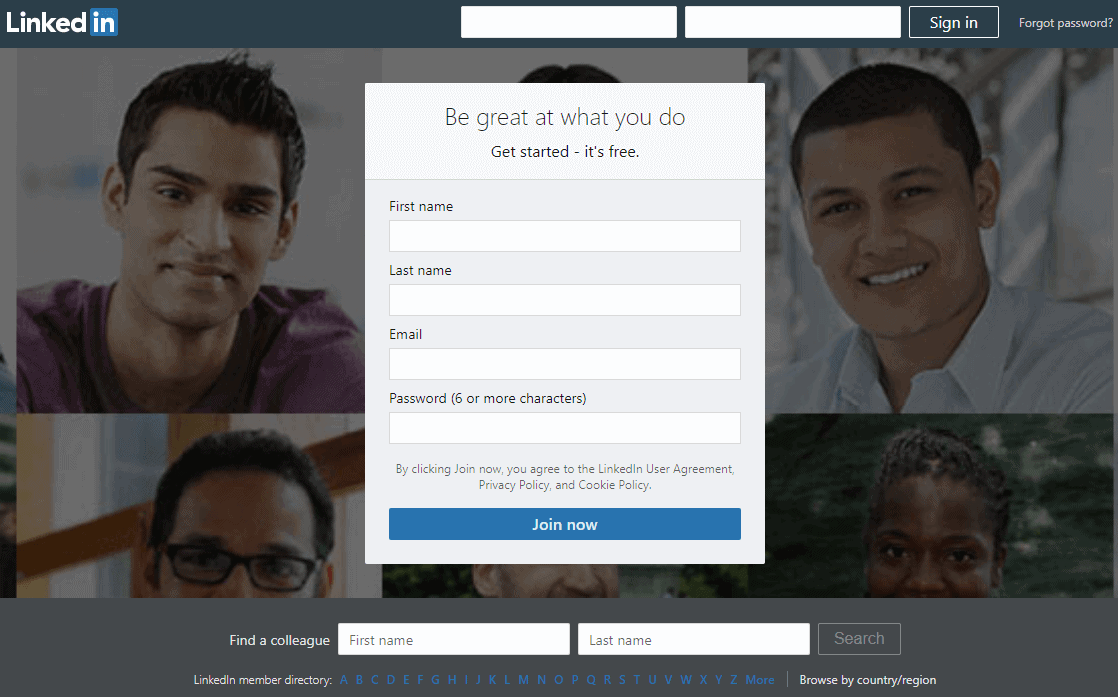
LinkedIn presents many opportunities to connect with other like-minded medical professionals and potential patients seeking information about health care, while also giving your practice a platform to market its services to the right audiences.
Today LinkedIn has over 540 million users in more than 200 countries globally, as well as millions of groups within the network. The time is now to tap into this social platform by building credibility for your medical expertise and spreading the word about your practice.
Here are 11 ways to market your practice on LinkedIn:
1. Define Your Goals and Target Audience
Step 1 in virtually any marketing effort should be defining goals and who you’re targeting. You’ll want to know who you intend to reach and why you are trying to reach them to know which tactics are going to work the best. Common uses of LinkedIn include:
- A lead generation platform
- A personal brand awareness platform
- A company brand awareness platform
- A job listing and hiring platform
When you have defined your intentions for using LinkedIn, you can start to pare down the more than half a billion users into a more defined target audience. Let’s say, for example, you are a varicose vein clinic trying to generate more patient bookings.
You know that nurses, delivery drivers, and factory workers are all at higher risk of developing varicose veins due to the nature of their jobs, so you could start by targeting members with job titles like “Registered Nurse”, “Production Technician”, and “Route Driver” with a brand awareness campaign via your company page and personal profile.
2. Update & Optimize Your Profile
Setup your profile to establish your presence as a medical professional on LinkedIn by filling out every section possible using specific and targeted keywords where possible. For example, if you are a Cardiothoracic surgeon, don’t just put Doctor for your title.
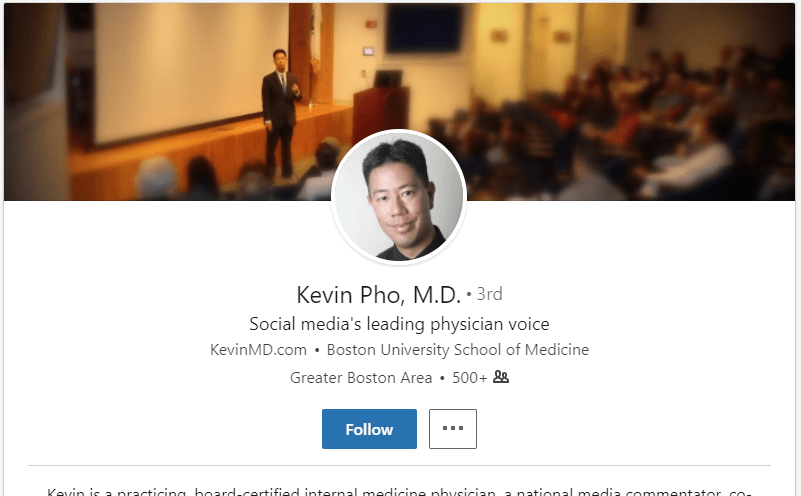
Set your headline, expand upon your experience in summary, and detail each role and duties you’ve had in your career. Add skills and expertise, add your education, including residencies and fellowships, and define your professional and personal interests.
Don’t neglect the summary section, which can often be the most overlooked area of LinkedIn profiles. With a generous limit of 2,000 characters, the summary is an opportunity to speak directly to your target audience and persuasively hit on their pain points. Your summary is an indispensable tool don’t waste it by skipping over it. Additionally, it’s a good idea to include contact information in your summary section. Even though LinkedIn provides numerous ways to contact and connect with you elsewhere on your profile, you want to make it easy for people to contact you.
Don’t forget to claim your custom URL! Each profile on LinkedIn can claim a custom URL; for example, Kevin Pho, who runs the popular healthcare blog KevinMD, has claimed https://www.linkedin.com/in/kevinmd/. Ensure it includes your name or other recognizable branding because many people will search Google for the names of people they are meeting or practices they want to learn more about. Claiming a custom URL with your name or branding makes it all the more likely your LinkedIn profile will rank well for those kinds of searches.
A completed and optimized profile helps to give a clear story of your professional experience, your present professional focus, and personal interests, and builds your credibility. Additionally, your completed and optimized profile perform better in LinkedIn search, based on the increased number of relevant keywords on your profile, which can be an excellent source of leads for networking.
Once your profile is completed and optimized, turn toward following companies of interest, top influencers on LinkedIn, and add new skills, achievements, and examples of your stellar work as posts on your profile. In addition to ranking well in search, you want people who find you to come across some detail that makes you stick out from your competitors.
Here is a list of medical professionals who’ve optimized their LinkedIn profile to the fullest, both to come up in search more frequently and to illustrate the unique offerings of their practice.
-
- Bryan Vartabedian
- Joesph Kim
- Jennifer Dyer
- Kevin Pho
- Wendy Swanson
3. Join Relevant LinkedIn Groups
Join groups on LinkedIn that spark your interest and are relevant to your professional goals as a medical practitioner.

The most popular groups of doctors on LinkedIn are Medical Doctor (MD) Network, Innovations in Health and Networking for Business Professionals & Doctors.
Join one those top networking groups for doctors or find another that suits your professional and personal needs. Start conversations with other members about the content or discussions they’ve posted or help answer questions posted in the group.
Providing value to the group with your specific medical background, especially if you’re a specialized physician, is a way to straighten your credibility and network of peers.
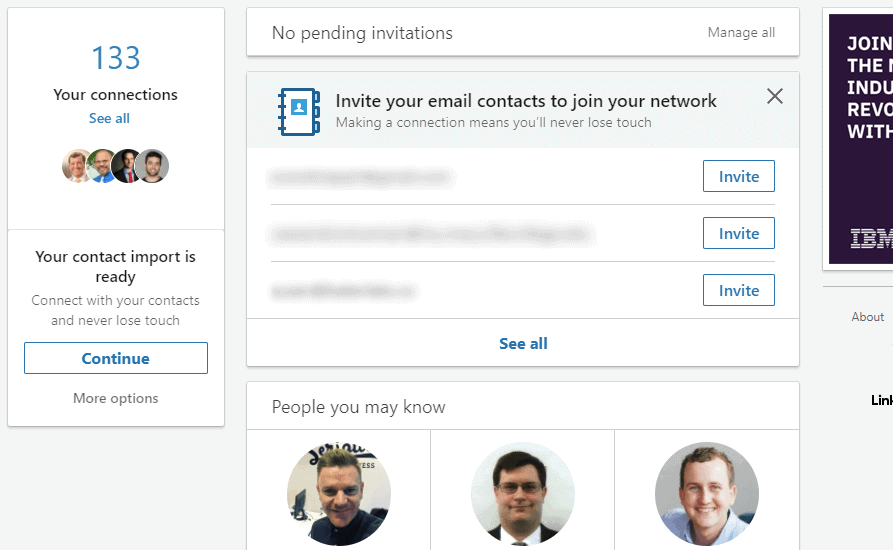 4. Connect with Other Professionals
4. Connect with Other Professionals
Begin adding other professionals to your network from the friends, coworkers, partners and peers that you already know by syncing your email with LinkedIn.
From there begin researching other trusted medical professionals in your local area that would be beneficial to connect with online. Think of LinkedIn as a mobile Rolodex of your most important contacts.
Once you’re active in the groups you’ve joined, feel free to start connecting with fellow group members if they are active in the community, are sharing valuable content, you’ve had productive conversations with or if they’d just be a good contact to have in the future.
5. Share Content with Your Network
Begin sharing content from your profile or in groups that reflect the practice areas your organization focuses on, which can either be content with your practice or relevant content from others in the medical industry. You can join up to 100 groups per account (choose wisely).
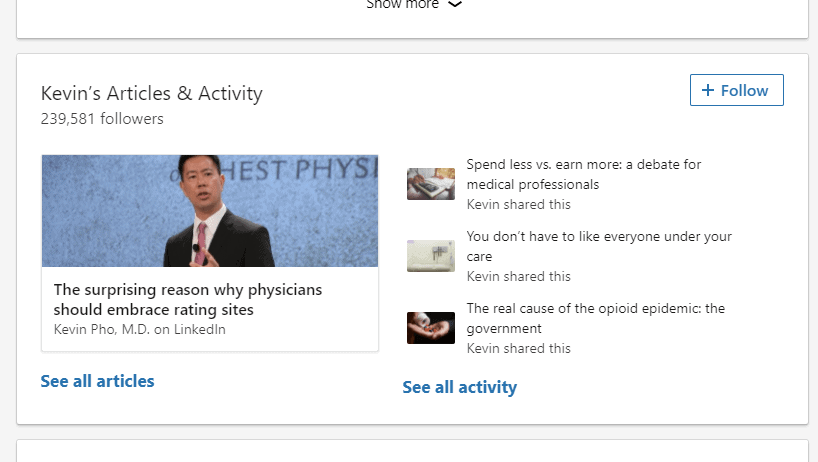
The type of content that should be shared on LinkedIn is strictly professional. Stick with sharing links, photos, and videos that you would feel comfortable as a representation of your practice.
A rule of thumb is to share content related to your industry or from your blog as a catalyst for professional discussions and analysis on the network.
6. Participate in Discussions
Once you are a member of a group related to your interests or practice areas on LinkedIn, it is important to have discussions with other group members. It isn’t enough to join a group and remain silent. Start a conversation by posting a question or a link to an article you’d like to discuss.

Otherwise, browse through the group to see what other members are posting about and commenting on. Join in the conversations by adding your viewpoint, expertise or friendly input.
By consistently having conversations with other professionals in the group, you’ll begin to build credibility about your expertise in front of a large audience of like-minded individuals that could be helpful to know for the future.
Offer advice and favors to others on LinkedIn to build your network and have a reliable group to reach out to in the future if your practice needs help or expertise in any way.
7. Drive Traffic to Your Blog & Website
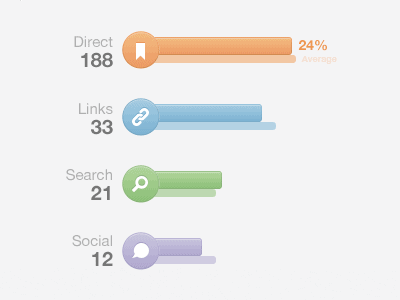 Post articles on your personal profile and in LinkedIn groups from your blog to help drive traffic to your best blog content. Share a healthy balance of your own content, as well as the content of others.
Post articles on your personal profile and in LinkedIn groups from your blog to help drive traffic to your best blog content. Share a healthy balance of your own content, as well as the content of others.
By offering your connections and other group members a variety of content, they are more likely to view you as source of quality information on your expertise as opposed to someone who is constantly sharing content about themselves and their practice.
Experiment with different copy in your posts to see what gets people to engage and click on your content. Post an article once on your profile and then again in a LinkedIn group using different copy and a different picture.
By alternating calls to actions and the way a piece of content is framed in a post, you can drive more traffic to the same piece of content then you would by only posting about it once.
8. Create and Publish Content on LinkedIn’s Publishing Platform
While sharing your content and content you find interesting that resonates with your audience is important, you should also be creating content directly on LinkedIn’s publishing platform. According to a recent post on their business blog, LinkedIn has “9 billion content impressions in LinkedIn feeds every week.” These articles are an opportunity to share your professional expertise in a longer form than updates and provide in-depth pieces about topics like challenges you’ve faced, opportunities you’ve seized, or important trends. Creating this content not only builds on the credibility of your optimized profile and external content, but also provides another stream of content for LinkedIn Search to index. For example, a dentist, who recently opened a practice and is looking to increase their professional network, could write a series about how they financed their new practice, market to new patients, and their most unexpected challenge and the solution.
9. Run Highly Targeted LinkedIn Ads for Connections and Patients
The audience targeting available with LinkedIn ads allows you to dial in your digital advertising to exactly the industries, company size and even job roles that fit your potential patients or referral partners. For example, if you are searching for referral partners, you can run an ad campaign on LinkedIn that targets other medical professionals active on the network located in your region. Are you trying to find patients instead of new additions to your referral network? LinkedIn is an effective way to target potential patients based on job titles, companies, or industries suggesting they may be at higher risk of conditions you treat. For example, a varicose vein specialist could run ads targeting people who work or have worked in education, trucking, and industrial sectors where working conditions can put workers at higher risk of developing varicose veins.
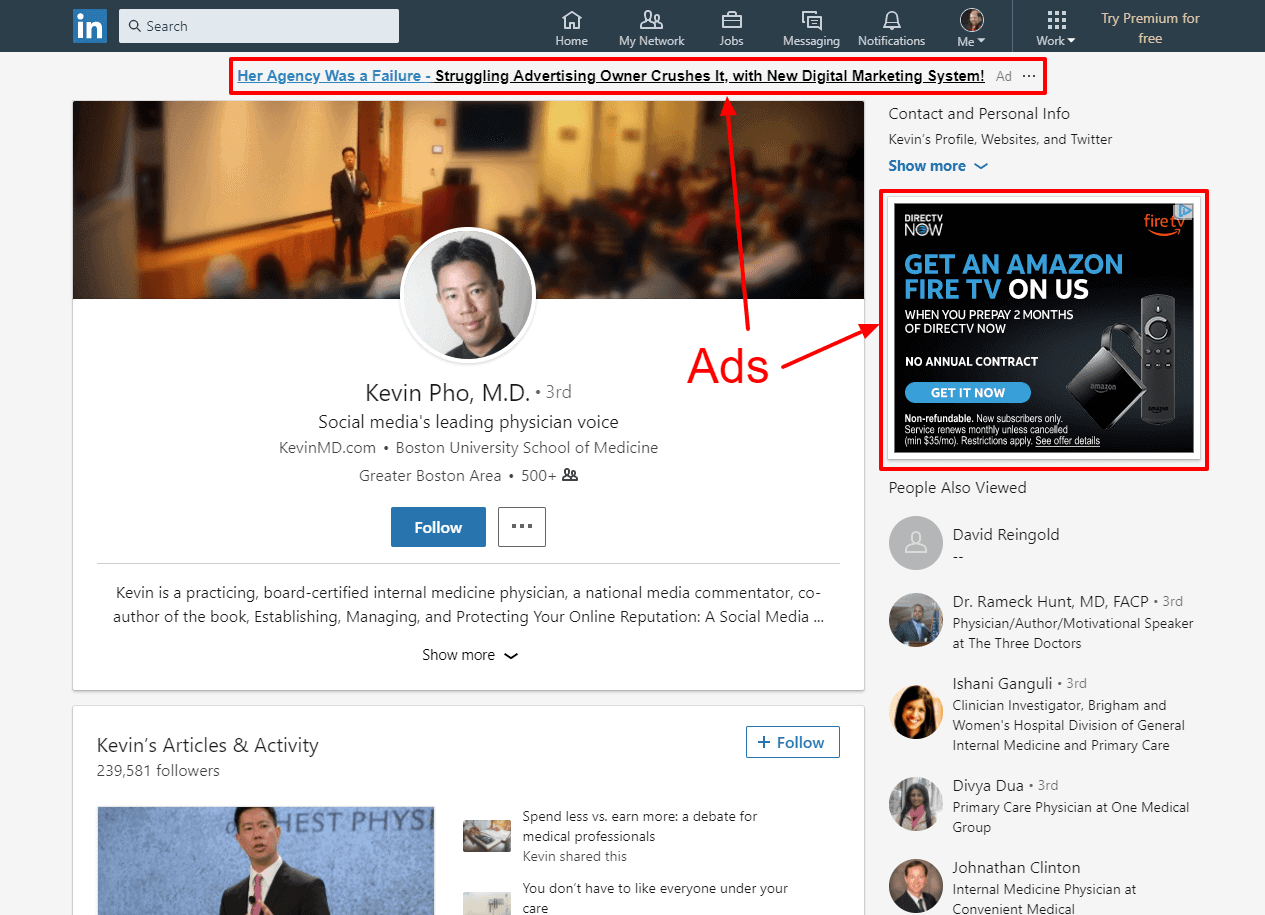
As seen above, ads on LinkedIn appear around a user’s profile as they browse the social network. Begin by identifying your target audience for these ads. What is the goal of your campaign and what calls to action would be the most appealing to relevant professionals on LinkedIn?
By answering these questions, you’ll be able to more effectively map out a campaign on LinkedIn that drives connections and results for your practice.
10. Give Recommendations & Endorsements
Recommend and endorse the work of other professionals in your network, not only does this help them gain credibility, but it also spreads good faith to past and present colleagues, peers and professional connections. LinkedIn allows you to create an economy of favors, in the form of recommendations and endorsements.
Leave recommendations and skill endorsements on LinkedIn as a thank you, as an act of good faith and an account of the credibility of the people in your network.

Recommendations are a long-form testament to your work and credibility written by other LinkedIn users. Your recommendations are listed on your profile and serve to support your credibility and reflect the caliber of work you do.
Recommendations shouldn’t be a one-way street. By leaving recommendations for colleagues and peers, you’re more likely to earn recommendations from others on your personal profile that can lead to more credibility to your practice and your personal brand on LinkedIn.
Endorsements are a one-click confirmation that an individual has one of the skills they’ve listed on their profile or a related skill. Look through the profiles of your colleagues and endorse them for the skills they excel at the most.
The more genuine endorsements given to members of your network, the more likely you are to get them in return and continue to build the credibility of your practice on LinkedIn.
11. Setup a Company Page for Your Organization
If you’ve optimized your personal profile, you’re halfway there. Now you need to optimize your practice “profile.” Think of a LinkedIn Company Page as a LinkedIn profile for your practice.
Setup a company page for your practice on LinkedIn. It doesn’t cost anything but time and it will allow your practice begin connecting with professionals on the network independent of your personal network.
Your company page allows page administrators to post content on behalf of the entire practice. It should offer ample opportunities for prospective customers or referral partners to learn more about your practice, the practitioners who work there, and engage with content relevant to the patients you serve and the treatments you offer.
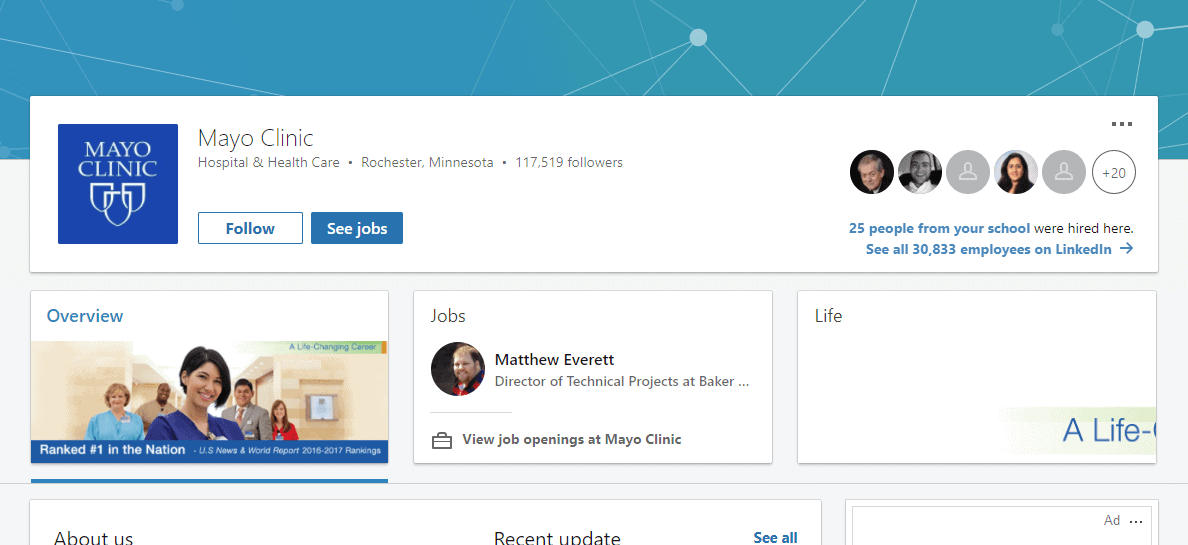
Add a cover photo to your page, as well as a full description of your organization and its focus. Take the Mayo Clinic’s LinkedIn page as an example to build from.
Post job openings, industry news, articles, awards the practice has won and any other content that is interesting and could be of value to your audience on LinkedIn.
LinkedIn offers sponsored updates that allow a company to pay to put content posted on a company page in front of more people on the network. This form of paid advertising allows your organization to drive quality leads from your LinkedIn updates that help build relationships, shape the perception of your practice and raise awareness to your unique offerings.
Highlight your unique expertise on your LinkedIn company page to gain the trust of others active on the network in the hopes of turning them into followers for your page and eventually, patients at your practice.
12. Optimize Your Company Page for Search
Don’t settle for merely creating your Company Page. If you want an effective Company Page that will help you build your audience on LinkedIn, you need to make sure it is optimized for search.
Whether searching on LinkedIn or off-site via a search engine like Google, a Company Page well-optimized for search will help boost rankings in search results and increase visibility to searchers. Like personal profiles, Company Pages are designed to be SEO friendly. Follow the following tips for easy and effective Company Page SEO:
- Insert keywords where practical. Be strategic in how you fill in details about your practice on your Company Page. Make sure you are incorporating keywords that clearly represent who you are and what you do, but from the perspective of your potential patients or referral partners.
- Link to your Company Page from other platforms and marketing materials. Links are an important component of any type of SEO. Creating links to your Company Page helps tie your page into your overall marketing efforts and is essential for boosting your ranking in search. Make sure you have links to your Company Page from your website, blog, and any other marketing materials as practical.
Something else to consider is ensuring employees and colleagues have up-to-date LinkedIn profiles that list your practice in their work history, which creates a link back to your Company Page from each of their profiles. Make sure your employees are also following the Company Page. Employees can often be some of your biggest advocates regularly sharing your content with their networks.
Promote your Company Page outside your practice as well by inviting patients, referral partners, and other key players in your business to follow your Company Page. Emails, newsletters, and blog posts are great places to encouraging readers to follow your practice page on LinkedIn. By following your page, your updates will appear directly in their LinkedIn feed. More followers mean higher potential reach for each item you publish to your Company Page.
- Share content relevant to your target markets. Finally, use your platform to share content that is related to your target audience. Not only does this keep your page updated indicating your practice is active, but it also improves your rankings and search results as updates published to your Company Page allow your content to be indexed by Google.
Your specific goal is to share and publish content that benefits and insights engagement from your target audience. Good indicators that content is resonating include clicks, shares, and comments. You shouldn’t shy away from promoting your own content and products or services every once in a while, but don’t be too “salesy” or overly self-promotional as this doesn’t generally resonate with potential patients or referral partners the way you think it will. The best way to approach this is to focus on helping your target audience perform their jobs better: answer questions, help address pain points, and highlight industry changes that could impact them.
When it comes to publishing your own content, LinkedIn is a great place to engage your audience with thought leadership content including:
- Industry thought leadership on news and trends in your industry.
- Organizational thought leadership on how your practice’s vision plays into their lives and addresses their pain points.
- Service/Treatment thought leadership highlighting how your treatments and services are the best solutions for your potential patients.
While you certainly want a good mix of media throughout your profiles, when possible you should focus on rich media, like photos and videos. Our brains are very efficient at processing images compared to text and posts with images receive more than six times more engagement compared to text alone.
Including compelling images, YouTube videos, and presentations in your updates is a great way to boost your engagement by catering to your audience’s craving for visual content.
How do you plan to use LinkedIn to build your practice? Which technique seems the most effective to find new patients, grow your referral network and build strong relationships with other medical professionals? Share your comments below!
Images courtesy of Michael Castro and Matt Bango.










